After his historical epic Sign of the Cross (1932), Cecil B. DeMille directed another ancient spectacle, Cleopatra (1934). His new star Claudette Colbert, fresh from her donkey milk bath in Sign of The Cross, played the politically shrewd, man-hungry queen of Egypt. In 48 BC, Cleopatra, facing palace revolt, welcomes the arrival of Julius Caesar (Warren William) as a way of solidifying her power under Rome. When Caesar, whom she has led astray, is killed, she transfers her affections to Marc Antony (Henry Wilcoxon) and dazzles him on a lavish barge. The film got five Oscar nominations, including one for Best Picture, and Victor Milner won the award for Best Cinematography.
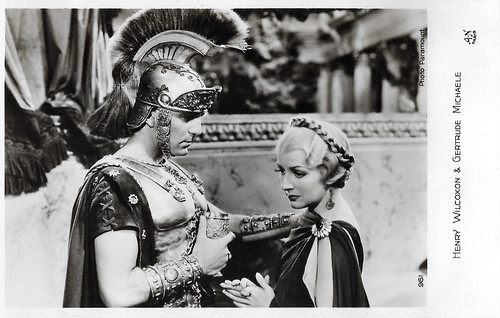
Henry Wilcoxon as Marc Anthony and Gertrude Michael as Caesar's wife Calpurnia. French postcard by A.N., Paris, no. 961. Photo: Paramount. Publicity still for Cleopatra (Cecil B. deMille, 1934).
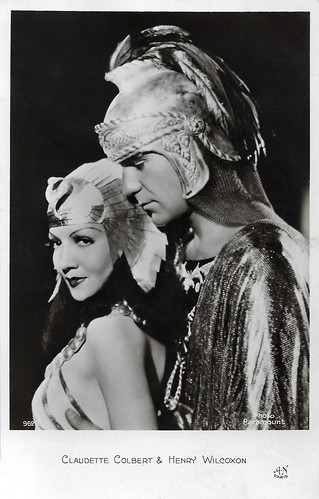
Claudette Colbert as Cleopatra and Henry Wilcoxon as Marc Anthony. French postcard by A.N., Paris, no. 962. Photo: Paramount. Publicity still for Cleopatra (Cecil B. DeMille, 1934).
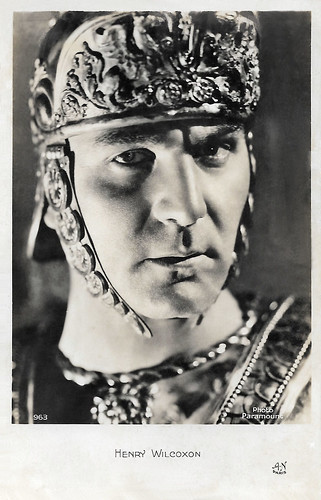
Henri Wilcoxon as Marc Anthony. French postcard by A.N., Paris, no. 963. Photo: Paramount. Publicity still for Cleopatra (Cecil B. DeMille, 1934).
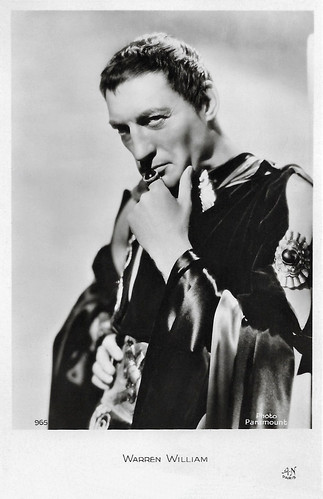
Warren William as Julius Caesar. French postcard by A.N., Paris, no. 965. Photo: Paramount. Publicity still for Cleopatra (Cecil B. DeMille, 1934).
Wikipedia: "On July 1, 1934, the Motion Picture Production Code began to be rigidly enforced and expanded by Joseph Breen had just taken effect. Talkie films made before that date are generally referred to as Pre-Code films. However, DeMille was able to get away with using more risque imagery than he would be able to do in his later productions. He opens the film with an apparently naked, but strategically lit slave girl holding up an incense burner in each hand as the title appears on screen."
Ron Oliver at IMDb: "Claudette Colbert is perfectly cast in the title role - deadly & fascinating, it's almost like watching a desert viper act. Exhibiting mega star wattage in arguably her best role, Colbert is one of the legendary actresses who could hold her own without being swallowed by the lavish costumes & sets which fill her every scene."
John O'Grady at IMDb: "Colbert is admittedly somewhat miscast (her face is altogether Parisienne), but she handles the part with considerable charm. Warren William, usually a very limited actor, is as good a Caesar as I have seen on film, commanding and uncomfortable by turns; while Henry Wilcoxon is the definitive Mark Antony, laughing, brawling, swaggering, crude and brooding. C. Aubrey Smith as Enobarbus, the last of the hardcore Roman republicans, is perfect. Victor Milner's cinematography is superb, if old-fashioned. There is one magnificent pullback shot aboard Cleopatra's barge, with more and more stuff entering the frame, which as pure cinema is worth more than all four hours of the Liz Taylor version for my money."
Tim Dirks at AMC Filmsite: "Unarguably, the Paramount Studios film is campy, grandiose and unreal and ludicrous historically - filled with DeMille's usual mixture of sin and sex. Sexually-suggestive costumes adorn most of the female characters."
Hal Erickson at AllMovie: "To emphasize the "contemporary" nature of the film, DeMille adds little modernistic touches throughout: The architecture of Egypt and Rome has a distinctly art-deco look; a matron at a social gathering clucks "Poor Calpurnia...well, the wife is always the last to know"; and, after Caesar's funeral, Mark Anthony is chided by an associate for "all that 'Friends, Romans, Countrymen' business!" Cleopatra's barge scene and her suicide from the bite of a snake marked two of the most memorable sequences in DeMille's career. Remarkably, for all the enormous sets and elaborate costumes, Cleopatra came in at a budget of $750,000 -- almost $40 million less than the 1963 Elizabeth Taylor remake."
Mario Gauci at IMDb: "The film features a number of great scenes: Caesar's murder (partly filmed in a POV (point of view) shot), following which is a delicious jibe at Antony's famous oratory during Caesar's funeral as envisioned by Shakespeare; the long - and justly celebrated - barge sequence, in which Antony (intent on teaching Cleopatra, whom he blames for Caesar's death, a lesson) ends up being completely won over by her wiles; Cleopatra's own death scene is simply but most effectively filmed."
Wikipedia: "The film is also memorable for the sumptuous art deco look of its sets (by Hans Dreier) and costumes (by Travis Banton), the atmospheric music composed and conducted by Rudolph George Kopp, and for DeMille's legendary set piece of Cleopatra's seduction of Antony, which takes place on Cleopatra's barge."
Robert Reynolds at IMDb: "This movie is a typical DeMille PRODUCTION, with all the strengths-gorgeous sets, costumes and a sort of grandeur to all the proceedings-as well as the weaknesses-the lavishness often comes at the expense of things like the story, acting and plot. There's no question that it's beautiful (although, interestingly enough, none of it's five nominations for Academy Awards was for Interior Decoration.)"
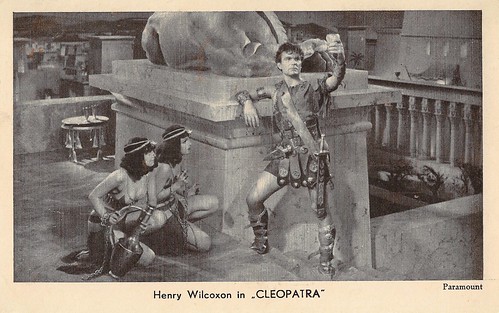
Henry Wilcoxon as Marc Anthony. Dutch postcard, promoting a visit to the American epic Cleopatra (Cecil B. DeMille, 1934). Photo: Paramount.
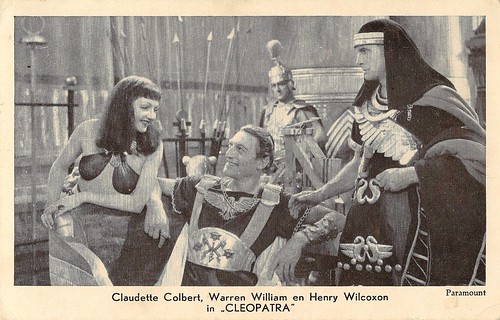
Dutch postcard, promoting a visit to the American epic Cleopatra (Cecil B. DeMille, 1934). Photo: Paramount. Credited on the card are Claudette Colbert (Cleopatra), Henry Wilcoxon (Marc Anthony) and Warren William (Julius Caesar). However, the guy on the right on this card is not Wilcoxon but Cleopatra's rival Pothinos (Leonard Mudie).
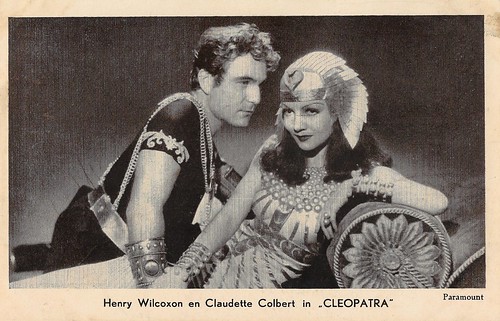
Dutch postcard. Photo: Paramount. Claudette Colbert as Cleopatra and Henry Wilcoxon as Marc Anthony in Cleopatra (Cecil B. DeMille, 1934).
Sources: Hal Erickson (AllMovie), Tim Dirks (AMC Filmsite), Wikipedia and IMDb.

Henry Wilcoxon as Marc Anthony and Gertrude Michael as Caesar's wife Calpurnia. French postcard by A.N., Paris, no. 961. Photo: Paramount. Publicity still for Cleopatra (Cecil B. deMille, 1934).

Claudette Colbert as Cleopatra and Henry Wilcoxon as Marc Anthony. French postcard by A.N., Paris, no. 962. Photo: Paramount. Publicity still for Cleopatra (Cecil B. DeMille, 1934).

Henri Wilcoxon as Marc Anthony. French postcard by A.N., Paris, no. 963. Photo: Paramount. Publicity still for Cleopatra (Cecil B. DeMille, 1934).

Warren William as Julius Caesar. French postcard by A.N., Paris, no. 965. Photo: Paramount. Publicity still for Cleopatra (Cecil B. DeMille, 1934).
Deadly and fascinating
Wikipedia: "On July 1, 1934, the Motion Picture Production Code began to be rigidly enforced and expanded by Joseph Breen had just taken effect. Talkie films made before that date are generally referred to as Pre-Code films. However, DeMille was able to get away with using more risque imagery than he would be able to do in his later productions. He opens the film with an apparently naked, but strategically lit slave girl holding up an incense burner in each hand as the title appears on screen."
Ron Oliver at IMDb: "Claudette Colbert is perfectly cast in the title role - deadly & fascinating, it's almost like watching a desert viper act. Exhibiting mega star wattage in arguably her best role, Colbert is one of the legendary actresses who could hold her own without being swallowed by the lavish costumes & sets which fill her every scene."
John O'Grady at IMDb: "Colbert is admittedly somewhat miscast (her face is altogether Parisienne), but she handles the part with considerable charm. Warren William, usually a very limited actor, is as good a Caesar as I have seen on film, commanding and uncomfortable by turns; while Henry Wilcoxon is the definitive Mark Antony, laughing, brawling, swaggering, crude and brooding. C. Aubrey Smith as Enobarbus, the last of the hardcore Roman republicans, is perfect. Victor Milner's cinematography is superb, if old-fashioned. There is one magnificent pullback shot aboard Cleopatra's barge, with more and more stuff entering the frame, which as pure cinema is worth more than all four hours of the Liz Taylor version for my money."
Tim Dirks at AMC Filmsite: "Unarguably, the Paramount Studios film is campy, grandiose and unreal and ludicrous historically - filled with DeMille's usual mixture of sin and sex. Sexually-suggestive costumes adorn most of the female characters."
Hal Erickson at AllMovie: "To emphasize the "contemporary" nature of the film, DeMille adds little modernistic touches throughout: The architecture of Egypt and Rome has a distinctly art-deco look; a matron at a social gathering clucks "Poor Calpurnia...well, the wife is always the last to know"; and, after Caesar's funeral, Mark Anthony is chided by an associate for "all that 'Friends, Romans, Countrymen' business!" Cleopatra's barge scene and her suicide from the bite of a snake marked two of the most memorable sequences in DeMille's career. Remarkably, for all the enormous sets and elaborate costumes, Cleopatra came in at a budget of $750,000 -- almost $40 million less than the 1963 Elizabeth Taylor remake."
Mario Gauci at IMDb: "The film features a number of great scenes: Caesar's murder (partly filmed in a POV (point of view) shot), following which is a delicious jibe at Antony's famous oratory during Caesar's funeral as envisioned by Shakespeare; the long - and justly celebrated - barge sequence, in which Antony (intent on teaching Cleopatra, whom he blames for Caesar's death, a lesson) ends up being completely won over by her wiles; Cleopatra's own death scene is simply but most effectively filmed."
Wikipedia: "The film is also memorable for the sumptuous art deco look of its sets (by Hans Dreier) and costumes (by Travis Banton), the atmospheric music composed and conducted by Rudolph George Kopp, and for DeMille's legendary set piece of Cleopatra's seduction of Antony, which takes place on Cleopatra's barge."
Robert Reynolds at IMDb: "This movie is a typical DeMille PRODUCTION, with all the strengths-gorgeous sets, costumes and a sort of grandeur to all the proceedings-as well as the weaknesses-the lavishness often comes at the expense of things like the story, acting and plot. There's no question that it's beautiful (although, interestingly enough, none of it's five nominations for Academy Awards was for Interior Decoration.)"

Henry Wilcoxon as Marc Anthony. Dutch postcard, promoting a visit to the American epic Cleopatra (Cecil B. DeMille, 1934). Photo: Paramount.

Dutch postcard, promoting a visit to the American epic Cleopatra (Cecil B. DeMille, 1934). Photo: Paramount. Credited on the card are Claudette Colbert (Cleopatra), Henry Wilcoxon (Marc Anthony) and Warren William (Julius Caesar). However, the guy on the right on this card is not Wilcoxon but Cleopatra's rival Pothinos (Leonard Mudie).

Dutch postcard. Photo: Paramount. Claudette Colbert as Cleopatra and Henry Wilcoxon as Marc Anthony in Cleopatra (Cecil B. DeMille, 1934).
Sources: Hal Erickson (AllMovie), Tim Dirks (AMC Filmsite), Wikipedia and IMDb.
No comments:
Post a Comment